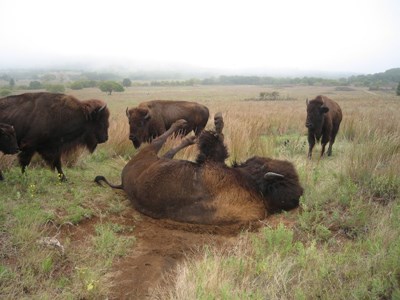Last updated: November 6, 2017
Article
Bison Bellows: Management of a Bison's Wild Character

Photo courtesy of M. Chavez/Wichita Mountains Wildlife Refuge.
In a world constrained by fencing, highways, and urban town centers, wildlife no longer have the complete ability to move freely and interact naturally across an intact landscape. Especially in parks and refuges that are surrounded by fences or urban developments, management of these wildlife species takes a different course than the species found on the open range. In terms of the largest mammal in North America---the American bison---management is necessary when movement, population growth, and ecological impacts must be addressed in accordance with the conservation and recovery of the species.
Essential to bison conservation, is the preservation of the species' wild character. With certain management strategies, some believe that current herd management can potentially eliminate a number of social and behavioral traits that can lead to the loss of the wild nature of bison. To maintain these wild characteristics, bison management must utilize certain methods such as maintaining a mix of age and sex classes, minimizing human handling, and allowing bison to interact naturally with the ecosystem
Maintaining different age and sex classes is vital for the preservation of certain behavioral traits in bison herds. If manages practice systematic removal and select individuals above or below a certain age, wild instincts and behaviors could be eliminated. For example, young calves learn behaviors from older individuals such as wallowing and horning. If managers remove individuals over nine years old from the herd, younger animals may not have a chance to observe these important natural behaviors. In addition, different age classes influence social interactions such as competition for food resources, social dominance in herds, and breeding opportunities. It is important to maintain these wild behaviors by limiting human interactions and allowing natural selection to take its course. Allowing bison to interact with their natural habitat is also central to conserving their natural behaviors. It is imperative bison practice natural foraging behaviors instead of providing supplemental feed on a regular basis. By allowing bison to forage naturally, the health of grassland ecosystems can increase as well. By interacting naturally in their ecosystem, bison can also be exposed to natural processes such as competition, predators, and diseases.
With the right management strategies, the wild characteristics of bison can be maintained. Bison management requires shared stewardship, and with the collaboration of multiple patterns, bison can have a chance to evolve and adapt as they naturally would.
